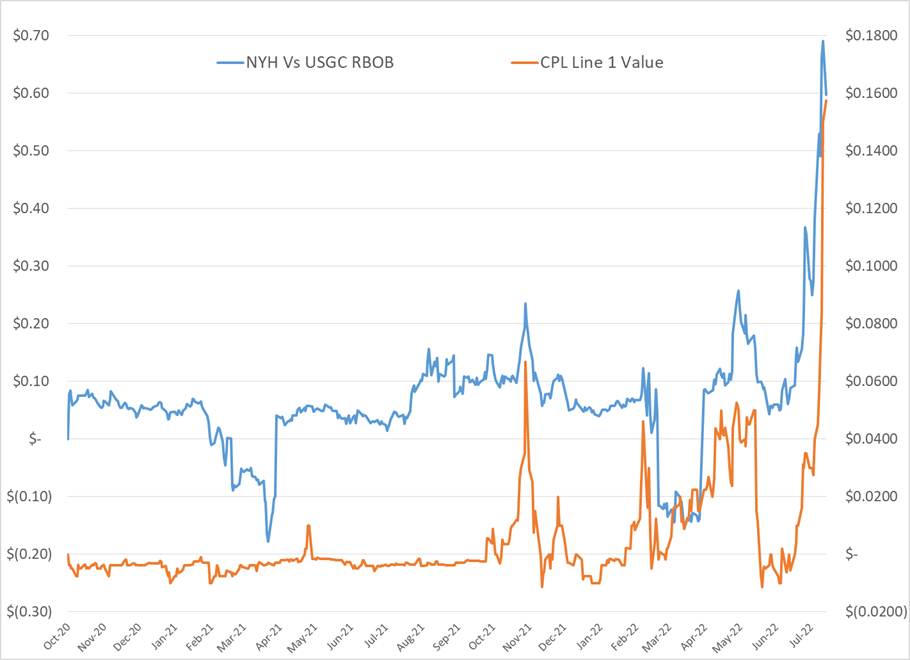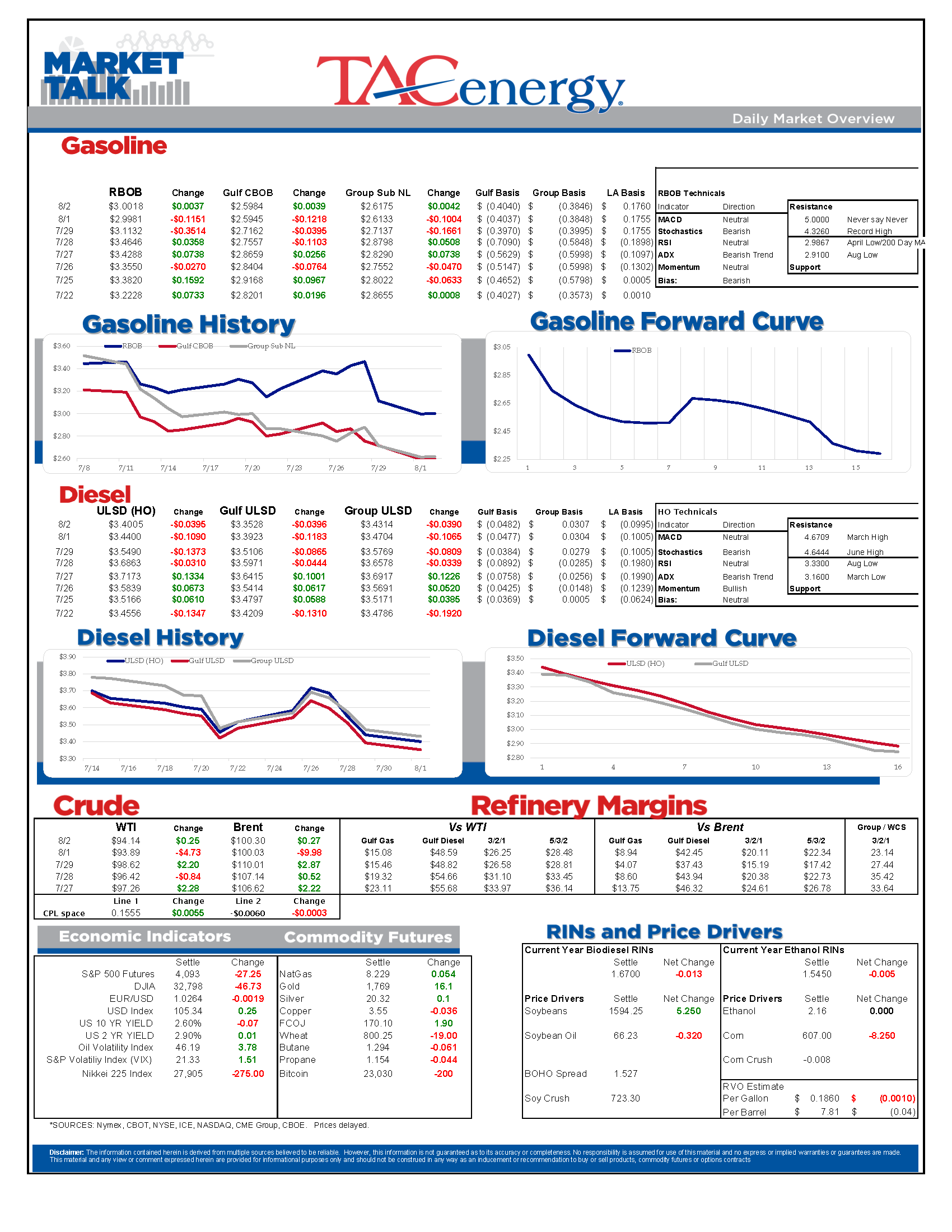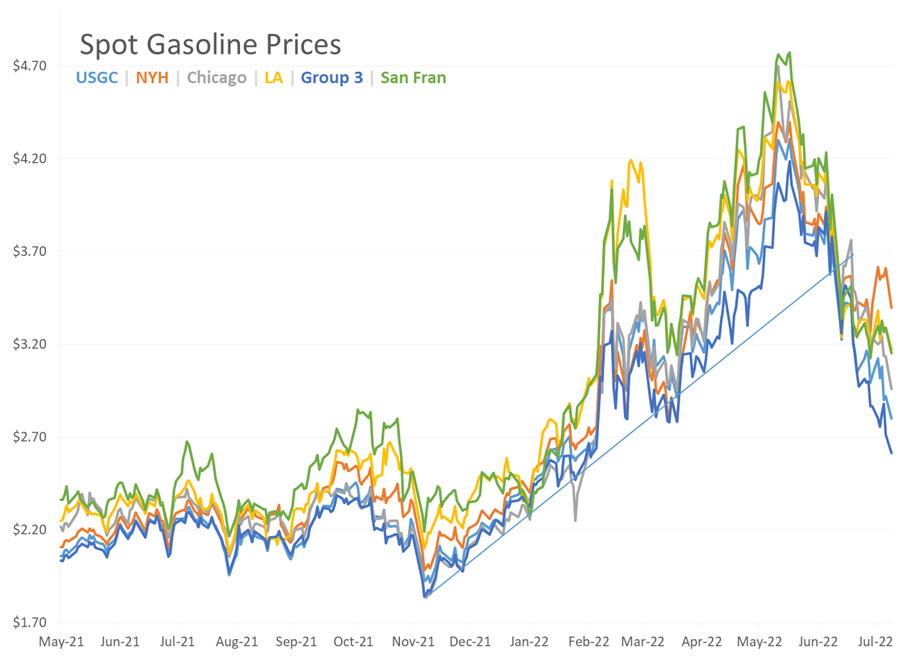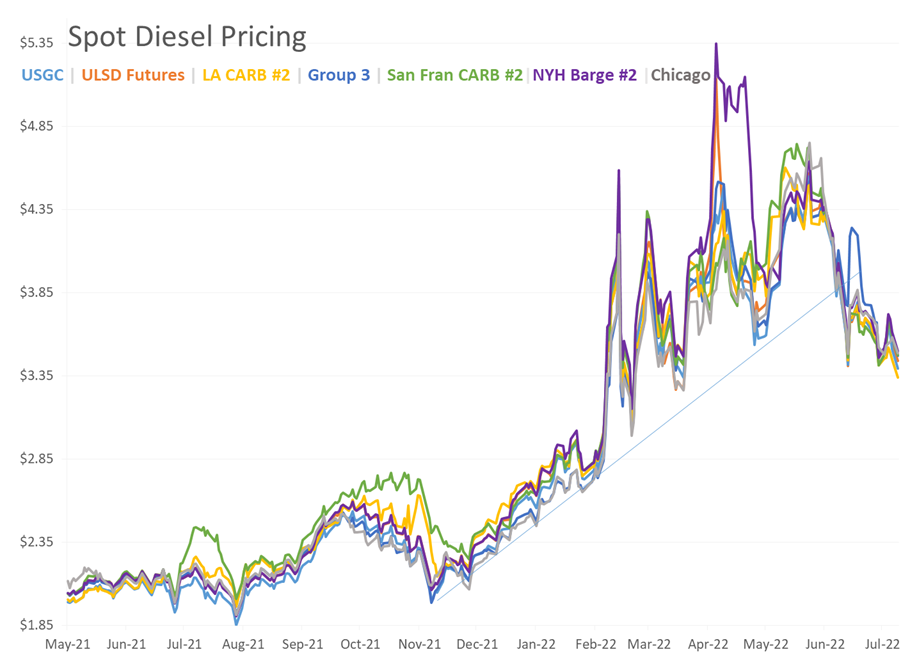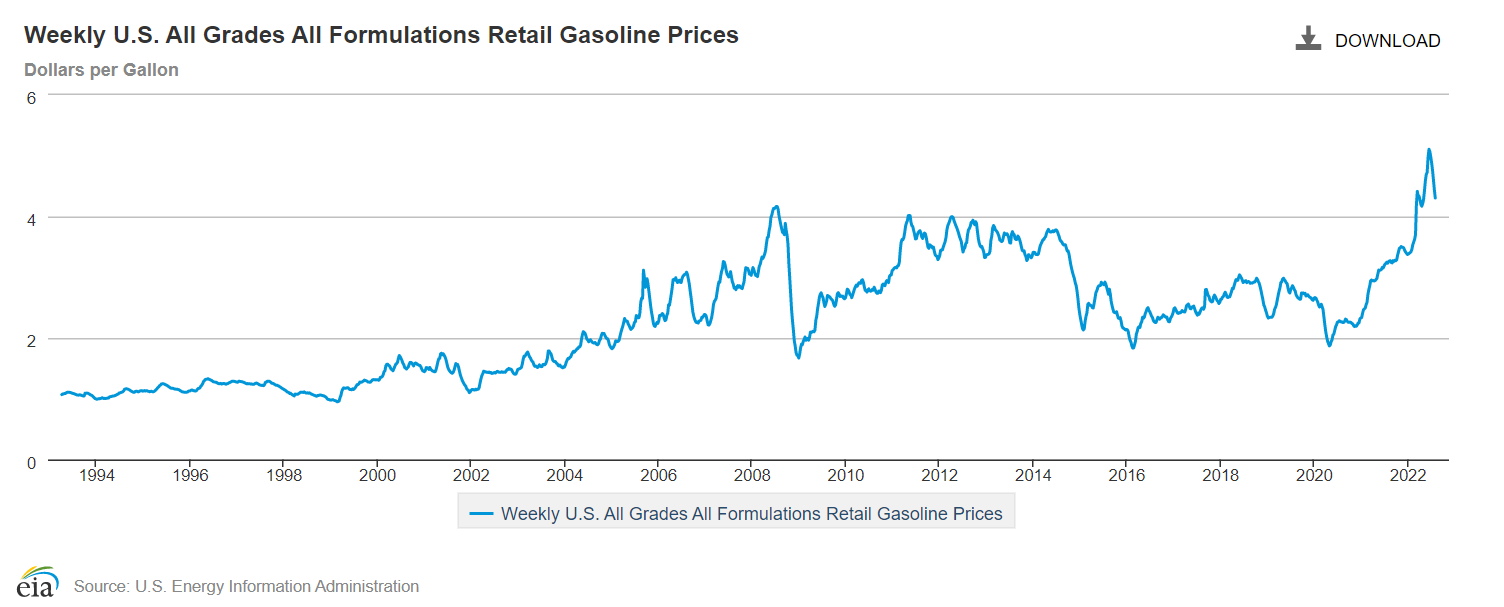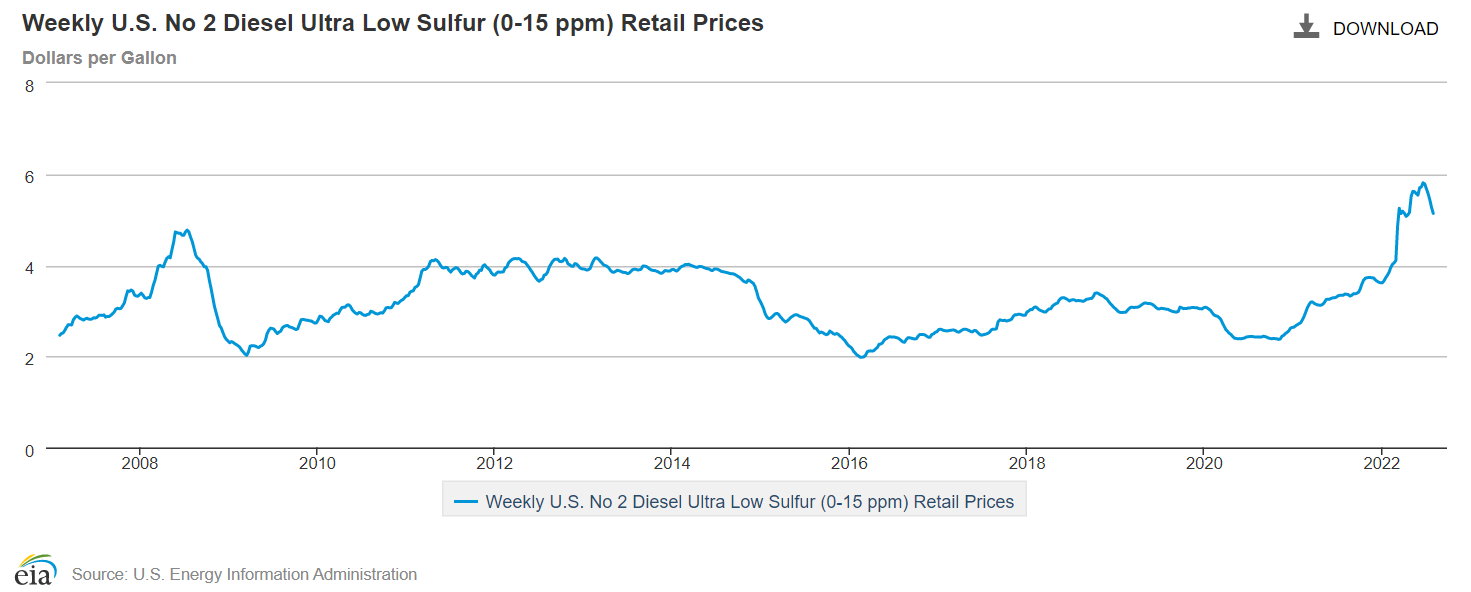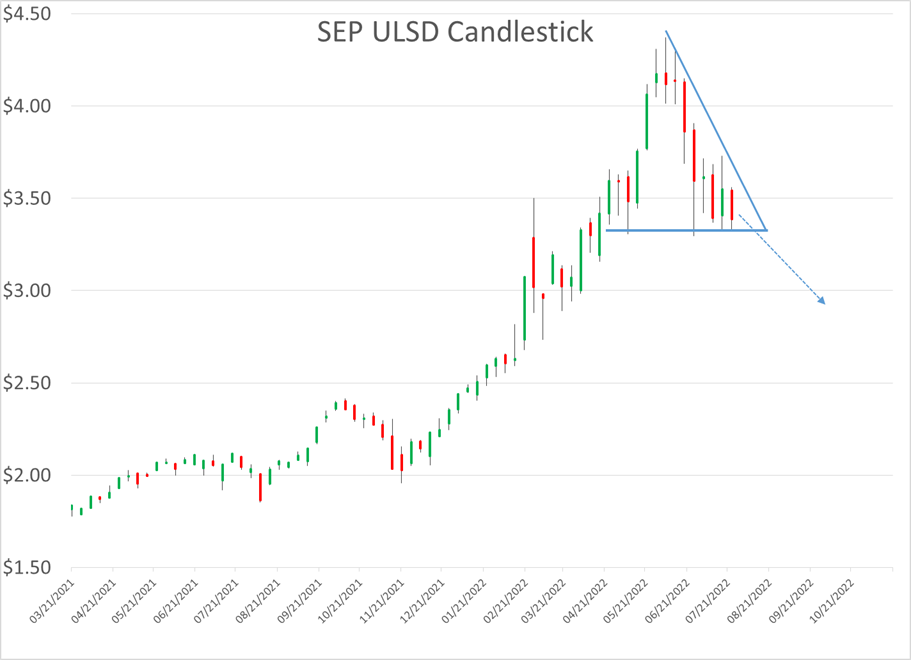Refined Product Prices Have Dropped To Their Lowest Levels In 4 Months As Fears Of A Slowing Economy

Refined product prices have dropped to their lowest levels in 4 months as fears of a slowing economy, and new tensions between the world’s two biggest economies, seem to be weighing heavily on various assets. The big drops this week have put the energy complex on the verge of a technical breakdown, but so far buyers continue to buy the dip, and keeping the chance of a continued sideways summer trading pattern intact.
Monday’s ISM Manufacturing survey got some of the credit for the big selloff in energy prices. Even though the survey showed that manufacturing in the US continued to grow, the pace was the slowest in 2 years, despite strong growth in energy production. The survey also suggested that post pandemic inventory restocking was winding down, which is likely to weigh on purchasing in the coming months. Right on cue, a Reuters article this morning notes that the country’s largest warehouse market is running out of room as consumer purchasing slows and inventories swell.
Retail fuel prices are set to continue dropping, and will soon be $1/gallon less than their June peak, which will be a key component to inflation readings decreasing. Perhaps the big question for the US economy, and energy prices for the rest of the year, is whether or not that drop in retail prices is enough to keep consumers from tightening their purse strings any further.
Diesel futures are potentially setting up a bearish descending triangle pattern on the charts, with a floor just below the $3.30 mark that could lead to a drop below $3 in the next few weeks should it break. Given the lack of diesel supplies globally, it’s hard to imagine this chart pattern could trump fundamentals, but relatively weak basis values across large parts of the US suggest we’re seeing at least a temporary reprieve in most of the inventory shortages, now we’ll just have to see if that lasts through the hurricane and harvest seasons.
The price to lease space on Colonial pipeline’s main gasoline line reached a 7.5 high this week as shippers race to take advantage of the huge premiums for gasoline in NY Harbor vs the US Gulf Coast. These premiums are yet another reminder of how the world’s supply and transportation network has been upended in recent months, after years of Colonial’s main line being unallocated and space trading for negative values since Europe was able to supply the excess gasoline consumed on the US East Coast. The forward price curve suggests the double digit premiums for line space will be short lived, but values could stay positive through the winter as that’s typically the strongest time of year as producers need to find new homes for their gasoline.
Click here to download a PDF of today's TACenergy Market Talk.
Latest Posts
Week 17 - US DOE Inventory Recap
The Energy Complex Is Trading Modestly Lower So Far This Morning With WTI Crude Oil Futures Leading The Way
Energy Futures Are Drifting Quietly Higher This Morning
Refined Products Holding Close To Break Even While Oil Prices Are Losing Just Under 1%
Social Media
News & Views
View All
Week 17 - US DOE Inventory Recap

The Energy Complex Is Trading Modestly Lower So Far This Morning With WTI Crude Oil Futures Leading The Way
The energy complex is trading modestly lower so far this morning with WTI crude oil futures leading the way, exchanging hands $1.50 per barrel lower (-1.9%) than Tuesday’s settlement price. Gasoline and diesel futures are following suit, dropping .0390 and .0280 per gallon, respectively.
A surprise crude oil build (one that doesn’t include any changes to the SPR) as reported by the American Petroleum Institute late Tuesday is taking credit for the bearish trading seen this morning. The Institute estimated an increase in crude inventories of ~5 million barrels and drop in both refined product stocks of 1.5-2.2 million barrels for the week ending April 26. The Department of Energy’s official report is due out at it’s regular time (9:30 CDT) this morning.
The Senate Budget Committee is scheduled to hold a hearing at 9:00 AM EST this morning regarding a years-long probe into climate change messaging from big oil companies. Following a 3-year investigation, Senate and House Democrats released their final report yesterday alleging major oil companies have internally recognized the impacts of fossil fuels on the climate since as far back as the 1960s, while privately lobbying against climate legislation and publicly presenting a narrative that undermines a connection between the two. Whether this will have a tangible effect on policy or is just the latest announcement in an election-yeardeluge is yet to be seen.
Speaking of deluge, another drone attack was launched against Russian infrastructure earlier this morning, causing an explosion and subsequent fire at Rosneft’s Ryazan refinery. While likely a response to the five killed from Russian missile strikes in Odesa and Kharkiv, Kyiv has yet to officially claim responsibility for the attack that successfully struck state infrastructure just 130 miles from Moscow.
The crude oil bears are on a tear this past week, blowing past WTI’s 5 and 10 day moving averages on Monday and opening below it’s 50-day MA this morning. The $80 level is likely a key resistance level, below which the path is open for the American oil benchmark to drop to the $75 level in short order.
Click here to download a PDF of today's TACenergy Market Talk.

Energy Futures Are Drifting Quietly Higher This Morning
Energy futures are drifting quietly higher this morning as a new round of hostage negotiations between Israel and Hamas seem to show relative promise. It seems the market is focusing on the prospect of cooler heads prevailing, rather than the pervasive rocket/drone exchanges, the latest of which took place over Israel’s northern border.
A warmer-than-expected winter depressed diesel demand and, likewise, distillate refinery margins, which has dropped to its lowest level since the beginning of 2022. The ULSD forward curve has shifted into contango (carry) over the past month as traders seek to store their diesel inventories and hope for a pickup in demand, domestic or otherwise.
The DOE announced it had continued rebuilding it’s Strategic Petroleum Reserve this month, noting the addition of 2.3 million barrels of crude so far in April. Depending on what the private sector reported for last week, Wednesday’s DOE report may put current national crude oil inventories (include those of the SPR) above the year’s previous levels, something we haven’t seen since April of 2022, two months after Ukraine war began.
The latest in the Dangote Refinery Saga: Credit stall-out, rising oil prices, and currency exchange.
Click here to download a PDF of today's TACenergy Market Talk.
